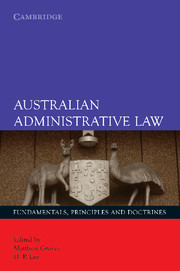Book contents
- Frontmatter
- Contents
- Foreword
- Preface
- About the contributors
- Table of cases
- Table of statutes
- 1 Australian administrative law: The constitutional and legal matrix
- 2 Administrative law in Australia: Themes and values
- 3 The public/private distinction in Australian administrative law
- 4 Australian administrative law: The human rights dimension
- 5 Administrative tribunals
- 6 Australian Ombudsman: A continual work in progress
- 7 Freedom of information
- 8 Delegated legislation
- 9 The concept of ‘justiciability’ in administrative law
- 10 Standing
- 11 Reasons for administrative decisions: Legal framework and reform
- 12 Relevant and irrelevant considerations
- 13 Improper purpose
- 14 Reasonableness, rationality and proportionality
- 15 The ‘no evidence’ rule
- 16 Failure to exercise discretion or perform duties
- 17 Procedural fairness: The hearing rule
- 18 The doctrine of substantive unfairness and the review of substantive legitimate expectations
- 19 The impact and significance of Teoh and Lam
- 20 The rule against bias
- 21 Jurisdictional error without the tears
- 22 Privative clauses and the limits of the law
- 23 Administrative law judicial remedies
- Endnotes
- Index
23 - Administrative law judicial remedies
Published online by Cambridge University Press: 05 June 2012
- Frontmatter
- Contents
- Foreword
- Preface
- About the contributors
- Table of cases
- Table of statutes
- 1 Australian administrative law: The constitutional and legal matrix
- 2 Administrative law in Australia: Themes and values
- 3 The public/private distinction in Australian administrative law
- 4 Australian administrative law: The human rights dimension
- 5 Administrative tribunals
- 6 Australian Ombudsman: A continual work in progress
- 7 Freedom of information
- 8 Delegated legislation
- 9 The concept of ‘justiciability’ in administrative law
- 10 Standing
- 11 Reasons for administrative decisions: Legal framework and reform
- 12 Relevant and irrelevant considerations
- 13 Improper purpose
- 14 Reasonableness, rationality and proportionality
- 15 The ‘no evidence’ rule
- 16 Failure to exercise discretion or perform duties
- 17 Procedural fairness: The hearing rule
- 18 The doctrine of substantive unfairness and the review of substantive legitimate expectations
- 19 The impact and significance of Teoh and Lam
- 20 The rule against bias
- 21 Jurisdictional error without the tears
- 22 Privative clauses and the limits of the law
- 23 Administrative law judicial remedies
- Endnotes
- Index
Summary
A rational system of law would start with matters of substance – it would prescribe legal norms. It would separately prescribe legal remedies for breach of those legal norms. It would provide a single procedure for a person claiming to be affected by a breach of a legal norm to apply to a court for a legal remedy. It would ultimately allow the court to grant whatever legal remedy was appropriate to the breach found. Unfortunately, a rational system of that nature has not been the legacy of the common law which has instead fastened ‘not upon principles but upon remedies’. Much of the development of administrative law in the last 150 years has involved attempts in various ways to create a system in which principle prevails and in which remedies are functional and subservient.
The historical legacy
It is sometimes forgotten that the whole of the common law was once administered through a system of ‘writs’. The writs were numerous but finite in number. Each had its own ‘uncouth name’. Each contained a unique command of the sovereign. Each was founded on a ‘form of action’ expressed or ‘endorsed’ on the writ in rigid and formulaic terms. The substantive law was constrained to fit the formulaic terms of the form of action but often strained against them. When a form of action failed to meet the demands of justice, the form prevailed and a ‘fiction’ was invented.
- Type
- Chapter
- Information
- Australian Administrative LawFundamentals, Principles and Doctrines, pp. 368 - 380Publisher: Cambridge University PressPrint publication year: 2007

